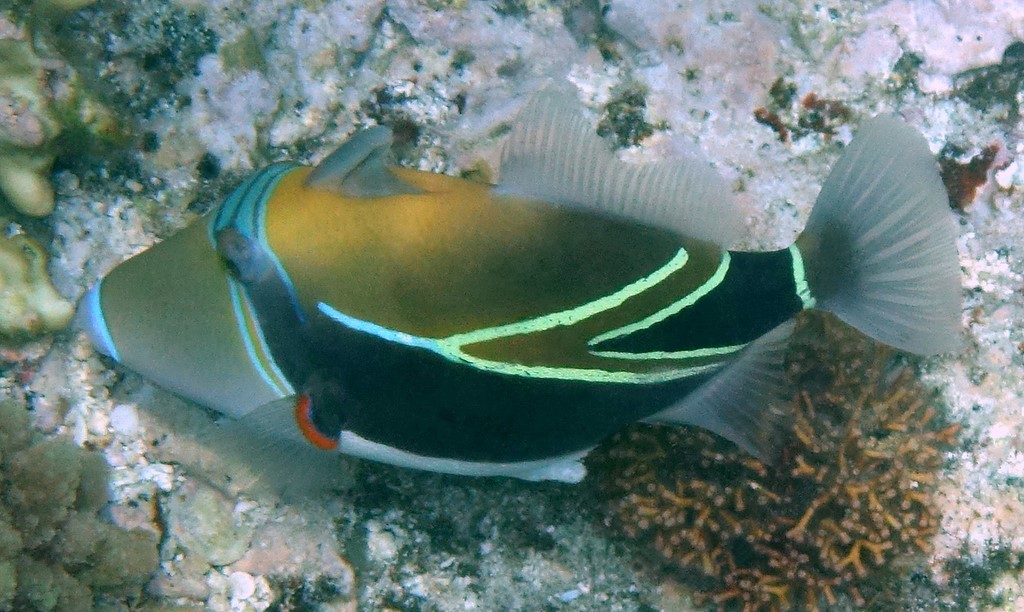RHINECANTHUS RECTANGULUS - (BLOCH & SCHNEIDER, 1801)
Picture courtesy of: Alain Daoulas
Actinopterygii (Gigaclass) > Actinopteri (Class) > Teleostei (Subclass) > Tetraodontiformes (Order) > Balistoidei (Suborder) > Balistidae (Family) > Rhinecanthus (Genus)
Baliste picasso à bandeau, Baliste picasso à triangle, Baliste écharpe, Wedgetail triggerfish, Reef triggerfish, Wedge-Tail triggerfish, Wedge-tail trigger-fish, Dark picasso-triggerfish, Patchy triggerfish, Black-banded triggerfish, Wedge-tailed triggerfish, White-barred triggerfish, Black-banded trigger-fish, Wedge triggerfish, Wedge picassofish, Rectangle trigerfish, Gelapte snellervis, Keil-picassodrücker, Porco rectangular, Tasukimongara, タスキモンガラ, 斜带吻棘鲀, 板机鲀,
Synonymes
Balistapus rectangulus (Bloch & Schneider, 1801)
Balistes cinctus (Hollard, 1854)
Balistes echarpe (Anonymous ex Lacepède, 1798)
Balistes erythropteron (Lesson, 1831)
Balistes fasciatus (Shaw, 1804)
Balistes garnoti (Castelnau, 1873)
Balistes medinilla (Quoy & Gaimard, 1824)
Balistes rectangulus (Bloch & Schneider, 1801)
Rhinecanthus echarpe (Anonymous ex Lacepède, 1798)
Rhinecanthus rectangulatus (Bloch & Schneider, 1801)
Rhinecanthus retangulus (Bloch & Schneider, 1801)
---------------------------
Description
Actinopterygii (Gigaclass) > Actinopteri (Class) > Teleostei (Subclass) > Tetraodontiformes (Order) > Balistoidei (Suborder) > Balistidae (Family) > Rhinecanthus (Genus)
Baliste picasso à bandeau, Baliste picasso à triangle, Baliste écharpe, Wedgetail triggerfish, Reef triggerfish, Wedge-Tail triggerfish, Wedge-tail trigger-fish, Dark picasso-triggerfish, Patchy triggerfish, Black-banded triggerfish, Wedge-tailed triggerfish, White-barred triggerfish, Black-banded trigger-fish, Wedge triggerfish, Wedge picassofish, Rectangle trigerfish, Gelapte snellervis, Keil-picassodrücker, Porco rectangular, Tasukimongara, タスキモンガラ, 斜带吻棘鲀, 板机鲀,
Synonymes
Balistapus rectangulus (Bloch & Schneider, 1801)
Balistes cinctus (Hollard, 1854)
Balistes echarpe (Anonymous ex Lacepède, 1798)
Balistes erythropteron (Lesson, 1831)
Balistes fasciatus (Shaw, 1804)
Balistes garnoti (Castelnau, 1873)
Balistes medinilla (Quoy & Gaimard, 1824)
Balistes rectangulus (Bloch & Schneider, 1801)
Rhinecanthus echarpe (Anonymous ex Lacepède, 1798)
Rhinecanthus rectangulatus (Bloch & Schneider, 1801)
Rhinecanthus retangulus (Bloch & Schneider, 1801)
---------------------------
Description
Dorsal spines (total): 3; Dorsal soft rays (total): 22-25; Anal soft rays: 20-22; Pectoral fin rays: 13-15; Lateral scale series: 33–39. Peduncle with 4 or (rarely: 5) longitudinal rows of small forward-projecting spines, rows extending to below rear part of soft dorsal fin; Caudal fin rounded, the corner acute. No groove before eye. Scales enlarged above pectoral-fin base and just behind gill opening to form a flexible tympanum. Max. length: 30.0 cm TL. Depth range: 1 - 12 m.
Color
Body pale brown dorsally, white ventrally; Black band from eye to gill opening and pectoral-fin base, continuing as broad black swathe to anal-fin base, this band edged posterodorsally with narrow golden line, which bifurcates below rear edge of first dorsal fin, lower line extending to rear part of anal-fin base, and upper line running to rear part of second dorsal-fin base; Broad blue band across interorbital space, containing 3 black
lines; Three blue lines extending downward from eye to pectoral region, posterior 2-3 lines forming edges of broad black band; Narrow blue line on upper lip; Peduncle with triangular black area, edged with narrow golden lines; narrow red line at pectoral-fin base.
Etymology
Rhinecanthus: from Greek, rhine = rasp + from Greek, acanthus = thorn or spine. Proposed as a subgenus of Balistes with a rough, instead of smooth, first dorsal-fin spine.
rectangulus: from Latin, rēctus = led straight along, drawn in a straight line, straight, upright + from Latin, angulus = an angle, a corner; Here = rectangular. Referring to its more angular body shape compared to other, more ellipsoid triggerfishes known at the time.
Original descritpion: Balistes rectangulus Bloch & Schneider, 1801 - Type locality: Mauritius, Mascarenes, southwestern Indian Ocean.
Distribution
Indo-West Pacific: East Africa, Seychelles, Comoros, Madagascar and Mascarenes east to Hawaiian Islands and Pitcairn Group, north to southern Japan and Ogasawara Islands (Japan), south to Lord Howe Island (Australia), New Caledonia and Kermadec Islands.
Biology
Occur in shallow outer reefs subject to surge. Commonly found over barren rock or the spur-and-groove zone where there is a mixture of bare rock, rubble, and coral. Juveniles on algae reef. Benthopelagic. Feed on algae, detritus, mollusks, crustaceans, worms, echinoderms, fishes, sponges, foraminiferans, and eggs. Territorial. Oviparous. Distinct pairing. Also taken by drive-in nets. Aquarium fish.
Last update: 27, March 2023
Body pale brown dorsally, white ventrally; Black band from eye to gill opening and pectoral-fin base, continuing as broad black swathe to anal-fin base, this band edged posterodorsally with narrow golden line, which bifurcates below rear edge of first dorsal fin, lower line extending to rear part of anal-fin base, and upper line running to rear part of second dorsal-fin base; Broad blue band across interorbital space, containing 3 black
lines; Three blue lines extending downward from eye to pectoral region, posterior 2-3 lines forming edges of broad black band; Narrow blue line on upper lip; Peduncle with triangular black area, edged with narrow golden lines; narrow red line at pectoral-fin base.
Etymology
Rhinecanthus: from Greek, rhine = rasp + from Greek, acanthus = thorn or spine. Proposed as a subgenus of Balistes with a rough, instead of smooth, first dorsal-fin spine.
rectangulus: from Latin, rēctus = led straight along, drawn in a straight line, straight, upright + from Latin, angulus = an angle, a corner; Here = rectangular. Referring to its more angular body shape compared to other, more ellipsoid triggerfishes known at the time.
Original descritpion: Balistes rectangulus Bloch & Schneider, 1801 - Type locality: Mauritius, Mascarenes, southwestern Indian Ocean.
Distribution
Indo-West Pacific: East Africa, Seychelles, Comoros, Madagascar and Mascarenes east to Hawaiian Islands and Pitcairn Group, north to southern Japan and Ogasawara Islands (Japan), south to Lord Howe Island (Australia), New Caledonia and Kermadec Islands.
Biology
Occur in shallow outer reefs subject to surge. Commonly found over barren rock or the spur-and-groove zone where there is a mixture of bare rock, rubble, and coral. Juveniles on algae reef. Benthopelagic. Feed on algae, detritus, mollusks, crustaceans, worms, echinoderms, fishes, sponges, foraminiferans, and eggs. Territorial. Oviparous. Distinct pairing. Also taken by drive-in nets. Aquarium fish.
Last update: 27, March 2023
